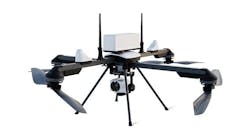Mar. 20—Pearland's police department has become the nation's first law enforcement agency to win Federal Aviation Administration approval to use a system in which drones controlled from a police station can be dispatched throughout a municipality to assess incidents, which officials say can save time, resources and lives.
"We'll be able to better assess a scene prior to getting an officer on the scene," said Herbert Oubre, a Pearland police officer and drone pilot. "We can either increase our resources going to a call or decrease those resources."
Instead of being controlled by operators stationed nearby or trailing in a vehicle, the police drones will rely on a technology called Casia G, developed by Iris Automation Inc., that enables remote airspace awareness during flight. The drones will use another system, called DroneSense, to relay information to the operator at the station.
The suburb south of Houston seems a fitting place to deploy the technology, as police have a lot of ground to cover. With 129,000-plus residents and 49 square miles, Pearland is a mix of subdivisions, hospitals, schools, colleges, and shopping centers.
The city also might become a model for other suburban police departments, many of which lack the financial resources to use first-responder aircraft such as helicopters.
In Pearland, "this will expand our capabilities exponentially because we don't have to have a visual observer," city police Lt. Jeff Jernigan said.
"It's real-time accurate information," Jernigan also said. "When you're talking about lives, it's seconds, not minutes that we have to get help to a scene, and that's what this allows us to do."
'Eyes on the ground'
Drone systems have been used by law enforcement agencies for years but operated under federal regulations requiring that operators be close enough to the drones to see the air space in which they are flying.
In 2018, the Chula Vista Police Department in California became the nation's first law enforcement agency granted FAA approval to use drones for emergency response but with the requirement that the drone pilots — working usually from rooftops or in vehicles — be able to see air space of up to two miles around a drone at any given time to ensure it doesn't collide with other aircraft.
"That meant you had to physically follow the drone to keep up with it, which isn't easy, because you might have it going over a shopping center or stadium or hospital," Iris spokesperson Ann O'Leary said. "What Casia G does is create an air space (view) for several miles, which means it can do a more efficient job than a human as an observer. They are eyes on the ground preparing (officers) ahead of time of what to expect from the scene."
Drones using the Casia G system can detect manned aircraft in the area and alert the drone operator.
The pilot can use real-time data from the system to identify the circumstances and geography at a scene, reducing response time, said Jernigan. For instance, he said, instead of casing an entire apartment complex, the drone will target a more precise area.
Privacy awareness
The department is developing a plan for how the Iris-driven system will be deployed and is keeping residents' civil liberties in mind, officials said. The city will cover the program's costs, which haven't been determined, said Jose Calderon, the city's assistant director of communications.
ACLU of Texas attorney Savannah Kumar said the city of Pearland and its police department bear responsibility to formulate clear, enforceable policies on use and retention of surveillance data, particularly when technological capabilities are increased.
"These programs have the power to track outdoor movements of all people wherever they go, threatening individual rights to privacy and free association under the First Amendment to the Constitution," Kumar said. Privacy violations could occur in scenes of residents that are captured peripherally by drone cameras, she cautioned.
She said of drones, "They can end up monitoring people's daily movement throughout the community in ways that are sensitive — for instance if someone is going to a psychiatrist. Most people would not feel comfortable sharing some of that information, and it really does become a deep invasion of privacy when you think about both the quantity and types of information this type of aerial footage can obtain."
Regarding privacy issues, the department bases its policies for first-responder drones on legal precedents and will follow any changes in that as the Iris program becomes functional, Jernigan said. The use of the Casia G technology, he said, will be restricted to emergency-response situations.
"We put on a training course specifically regarding case law, and because the technology is still fairly new, new case law comes out often," Jernigan said. "There are laws, rules and department regulations that govern when and how drones are used."
The department spent the past year testing, collecting and analyzing data and submitted those findings to the FAA for approval, which is a major step in the wider acceptance of drone technology and innovations, said O'Leary.
" Pearland has been very forward-thinking, and that's what it takes to be open to this type of technology," she said. "We know these first responders are dealing with tough situations and this helps them be better prepared."
___
(c)2023 the Houston Chronicle
Visit the Houston Chronicle at www.chron.com
Distributed by Tribune Content Agency, LLC.

